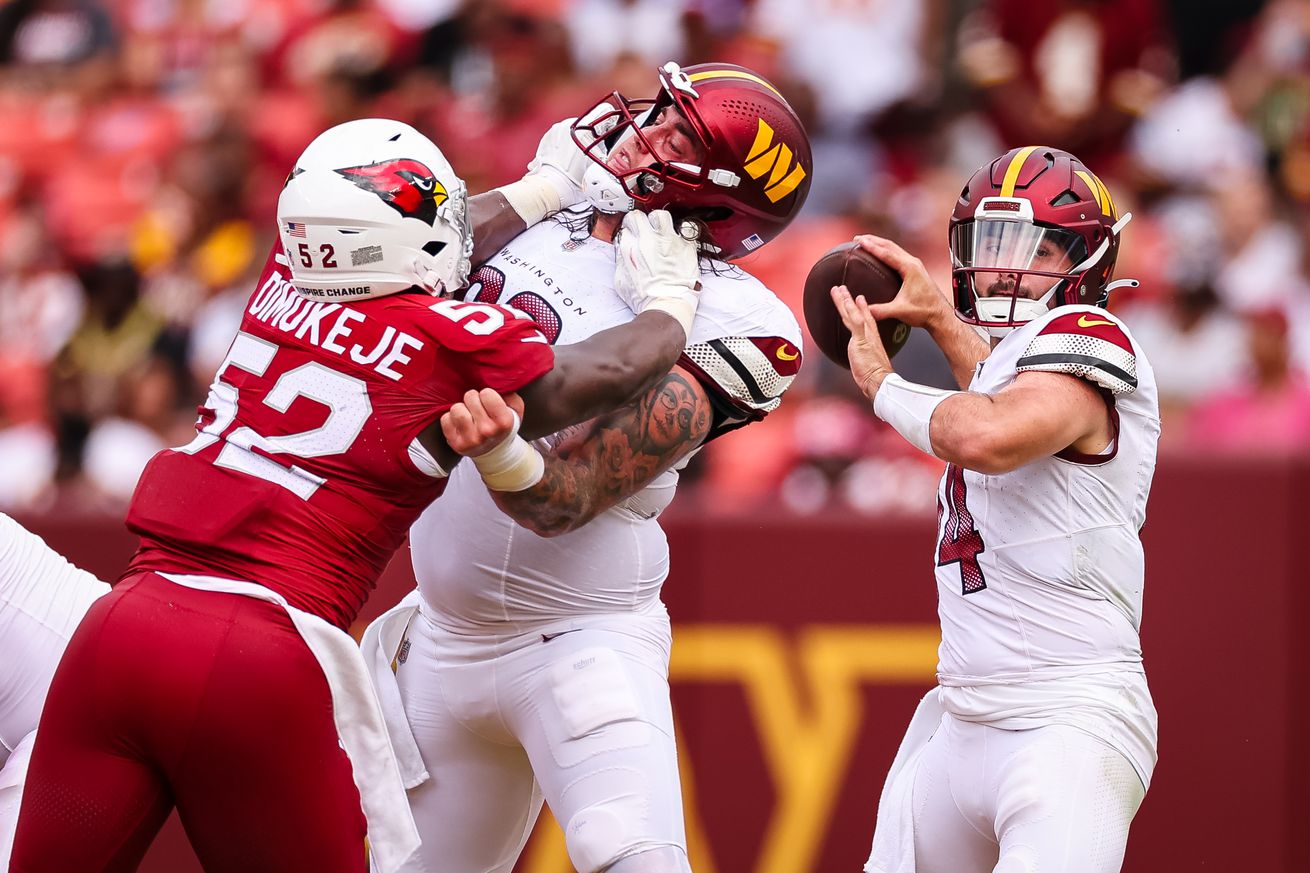
Some facts to help separate myth from reality
The offseason discussion on Hogs Haven has had a major emphasis on the offensive tackle position. This appears to have been driven by a belief that the Commanders’ starting offensive tackles were mainly to blame for Sam Howell’s struggles with pass rush pressure in 2023 and that the new front office did not do enough to shore up the position for 2024.
The concern over the perceived lack of action to bring in free agents and draft offensive tackles has reached a fever pitch among some commenters. Trying to draft offensive tackles who could outcompete average NFL veterans would have been a challenge. Now that the draft is over, we are hearing calls to bring in veteran free agents who were demonstrably worse than Washington’s 2023 starters just to do something about the position.
In 2023, RT Andrew Wylie was the weaker of the Commanders’ OTs in pass protection. He allowed QB pressures on 6.06% of blocking snaps (6.06% Pressure Rate). Some of the names that have been thrown around as potential replacements this offseason, along with their 2023 Pressure Rates in pass protection are:
- Tyron Smith – 3.44%
- Mike Onwenu – 4.55%
- Jermaine Eluemunor – 5.07%
- Jonah Williams – 5.62%
- Josh Jones – 5.92%
- Walker Little – 5.92%; trade target
- Mekhi Becton – 7.76%
- Donovan Smith – 7.70%
- Dan Moore Jr – 9.66%
- D.J. Humphries – 4.93%, rehabbing ACL torn in January
- La’el Collins – did not play in 2023 following torn ACL/MCL in 2022
- David Bakhtiari – Age 32, rehabbing surgery to repair consequences of 2021 ACL surgery
The level of concerns being raised about the offensive tackle position in some quarters, as well as some of the proposed solutions, do not appear to be proportionate to the actual problem. In fact, the Commanders’ offensive tackles, as a group, did not even yield the most pressures or sacks along the offensive line in 2023. That suggests that the concerns being expressed are based on an incomplete understanding of the Commanders’ issues in pass protection last season.
To shed some light on this topic, I undertook an analysis of the factors which contributed to Sam Howell having the sixth-highest Sack Rate among starting QBs in 2023 (min. 8 starts).
The factors examined included offensive scheme basics, the 2023 starting offensive tackles, where the pressures came from, and quarterbacks’ ability to avoid pressure.
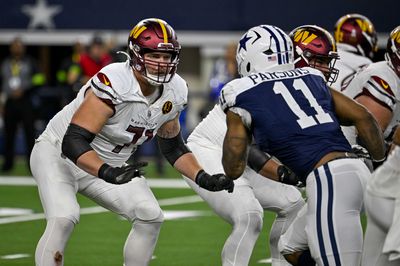
Jerome Miron-USA TODAY Sports
Commanders’ 2023 Offensive Scheme Basics
No matter how good a team’s offensive line is at preventing pressures, and no matter how good their quarterback is at avoiding them, their sack total will increase in proportion to how often they throw the ball. This mainly comes down to simple math. If an offensive line gives up pressures at a certain rate, and the QB converts pressures to sacks at a certain rate, then increasing the number of pass rush attempts they are exposed to will increase the number of sacks the QB takes. Failing to establish a legitimate running threat also allows defenses to key on rushing the passer, making the problem even worse.
This factor is completely under the team’s control.
In 2023, rather than easing first year starting QB Sam Howell into the NFL, offensive coordinator Eric Bieniemy made the baffling decision to have him lead the most pass-heavy offense in the league. The Commanders led the NFL in total passing attempts (636) and percentage of passing plays (66.1%).
What made this decision particularly perplexing is that Howell had been known to have weak pocket awareness, causing him to take too many unnecessary sacks in college. Rather than scheme to conceal their young QB’s major weakness, the Commanders chose to give it maximum exposure. It is no surprise that Howell struggled, or that Bieniemy was unable to find another NFL job.
The easiest fix at the Commanders’ disposal in 2024 is to run a more balanced offensive attack, to limit Jayden Daniels’ exposure to the pass rush. This obviously includes running the ball more than Bieniemy did in 2023. As part of their roster “recalibration” the Commanders bolstered the interior offensive line, which should help in that regard.
The Commanders also made upgrades to the TE position. As Senior VP of Strategy Eugene Shen has observed, use of tight ends as receiving options has added benefits to the running game, since it keeps defenses from guessing whether a play will be a pass or a run:
Love this snip-it from Eugene Shen NEW WSH Senior VP of Football Strategy as he discusses how underrated and important it is have to have a game changing tight end. #HTTC pic.twitter.com/YjdJn2zpgp
— Adam Aniba w/ The Burgundy and Gold Report (@TheBandGreport) November 3, 2023
Furthermore, second round draft pick Ben Sinnott excels as a run blocker, and can even double as a weapon in the run game himself.
Commanders’ fans can take heart from the fact that incoming offensive coordinator Kliff Kingsbury ran a balanced offensive attack in his previous stint with the Arizona Cardinals. In fact, for half of his tenure, the Cardinals were one of the more run-oriented teams in the league. Over Kingsbury’s four seasons in Arizona from 2019 through 2020, the Cardinals ranked 19th, 6th, 7th, and 20th in rushing attempts.
If the Commanders simply make the expected adjustments to the offensive scheme to help a rookie QB, Jayden Daniels should have a much easier time settling in than his predecessor.
How Bad Were Washington’s Starting Offensive Tackles?
The situation at OT has been a focal point of discussion on Hogs Haven this offseason. Some commenters have suggested that the Commanders’ starting offensive tackles in 2023 were the worst in the NFL and practically anyone else with a pulse that the team could get in would be sure to be an improvement.
In my previous article, I compared the pass blocking performance of Andrew Wylie and Cornelius Lucas to the 83 OTs who played a minimum of 200 pass blocking snaps. Wylie ranked 41st and Lucas ranked 27th in that analysis, suggesting that the Commanders presumptive starters in 2024 were closer to the middle of the pack than worst in the league in pass protection.
Here I took a more painstaking approach to rank the Commanders’ 2023 starting OTs amongst the starting left and right tackles of the other 32 teams based on Pressure Rate allowed in pass protection. In some instances, this involved counting starts and snaps to determine who the intended starter was, vs backups filling in. Where an intended starter got minimal playing time, I counted the backup as the starter. Rookies are designated by asterisks.
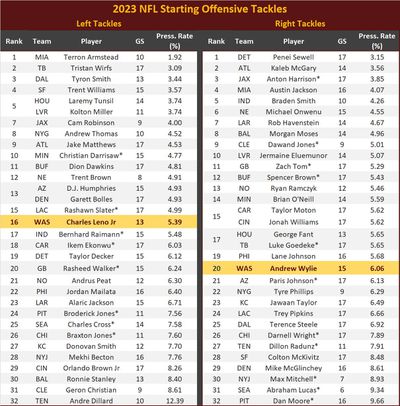
In agreement with the previous analysis, Washington’s 2023 starting OTs ranked in the second and third quartiles at their respective positions among NFL starters. Presumptive 2024 starting LT Cornelius Lucas started four games in relief of Charles Leno Jr and recorded a Pressure Rate of 5.26%. That would have ranked 16th amongst NFL starters in 2023, if he had played the season instead of Leno.
Neither of Washington’s 2023 starting OTs ranked in the bottom third of NFL starters in pass protection. The suggestion that they were amongst the worst pass blockers in the league is not supported by the facts.
Where Did the Pressure Come From?
While much of the offseason discussion has focused on the need to bolster protection on the edges of the offensive line, the Commanders were also vulnerable to interior pressure in 2023. To see where the biggest issues on the Commanders’ O-Line were last season, I did breakdown of total QB pressures by position group and individual players.
These data were compiled from the players who saw the most pass block snaps at each position. I set a snap count threshold to capture the top 64 OTs and guards and the top 32 centers. This approximates the starters at each position around the league, but not as exactly as the more painstaking approach in the previous section. When I refer to the “top n” players at a position, it is referring to playing time in pass protection. In most cases the top player(s) on a team are the starters. There were also a few backups pressed into service.
When a player’s position rank is in parenthesis, it means he didn’t meet the snap count threshold. In these cases, the rank is where he would have fit into the rank order if he had played enough snaps.
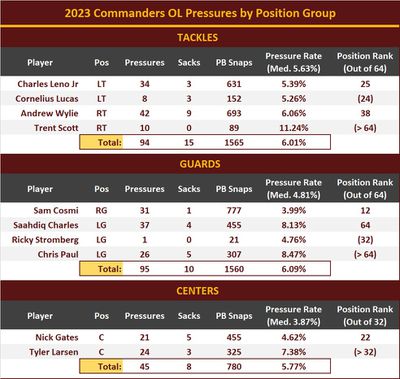
Total QB Pressures
Total QB pressures were distributed close to evenly between the three OL position groups, when the number of players on the field is taken into account. 94 QB pressures were attributed to the OTs (2 starters), 95 to the guards (starters), and slightly less than half as many were attributed to the centers (1 starter).
Aggregating total pressures by interior offensive line and offensive tackles reveals that 140 pressures (59.8%) came from the came from the interior and 94 (40.1%) came from the edges. That distribution of pressures made Washington somewhat unusual. The average (median) NFL team had 51.5% of pressures come from the interior. The Commanders had the 7th most pressure generated from the interior of the offensive line among NFL teams.
Within the Commanders’ OT group, pressures were evenly split between LT and RT. The distribution of pressures among the guards was extremely lopsided, with 67% coming from the left side compared to only 33% from the right side.
The total QB pressure data might seem to suggest that the three O-Line position groups were equally to blame for the Commanders’ struggles in pass protection. However, that was far from the case.
Pressure Rates by Position Group
The group level Pressure Rates for the three OL positions are fairly similar, with the guards allowing slightly more pressures than the OTs, who allowed slightly more than the centers. Does that mean that the three position groups were equally bad at pass blocking?
Not really. The three O-Line position groups are expected to allow different Pressure Rates because they experience different levels of pass rush activity.
Across the league, OTs normally face the most pass rush attempts from the best pass rushers, and therefore allow highest Pressure Rates of the three position groups. As a group, centers allow the lowest Pressure Rates. The median Pressure Rates for the top 64 OTs and guards were 5.63% and 4.81%, respectively. The median Pressure Rates for the top 32 centers was 3.87%.
Consequently, a Pressure Rate that is significantly worse than average for a starting center might be significantly better than average for starting OT. A center who allowed a Pressure Rate of 3.87% of blocking snaps would be exactly on average for starters at his position. An offensive tackle who allowed the same Pressure Rate would be the 10th best out of 64 starters at his position.
Once differences between position groups are taken into account, it becomes clear that the offensive tackles were the Commanders’ strongest O-Line position group in pass protection in 2023. They were the strongest group on a weak O-Line. Their group-level Pressure Rate of 6.01% was just 0.38 percentage points higher (worse) than median of the top 64 OTs.
The guards were the next least-deficient pass protectors for the Commanders, relative to the league-wide average for starters at their position. Their group-level Pressure Rate of 6.09% was 1.19 percentage points above median for the position.
The centers had the lowest group-level Pressure Rate on the Commanders’ O-Line at 5.77% of pass block snaps. However, centers are expected to have much lower Pressure Rates than OTs. When compared to the position group median of 3.87%, they were actually the most underperforming group relative to expectations at 1.9 percentage points above the median.
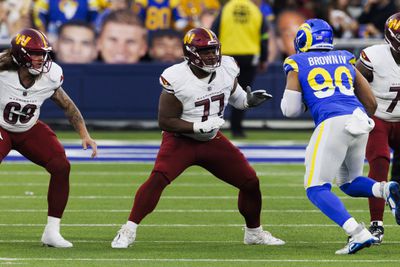
Photo by Ric Tapia/Getty Images
Individual Pressure Rates
Getting back to where all this started, RT Andrew Wylie allowed the most total pressures of any player on the offensive line. Does that mean he was the worse pass blocker on the offensive line? As it turns out, a few of the Commanders’ offensive linemen were substantially worse.
Measuring pass blocking performance as Pressure Rates adjusts for differences in playing time. To also account for differences in Pressure Rates between position groups, I ranked each of the Commanders’ offensive linemen by Pressure Rate within the top 64 or 32 players at their positions (Position Rank, right column in the table).
The best pass protector on the Commanders’ offensive line, by far, was RG Sam Cosmi. His Pressure Rate of 3.99% was the 12th lowest out of the top 64 guards, which puts him at the 81st percentile of players at his position. The next best O-Line starters were offensive tackles Charles Leno Jr. and Andrew Wylie, who ranked just above and below the median for their position, respectively. Contrary to the hype that Wylie is the worst offensive tackle in the NFL, his Pressure Rate placed him at the 41st percentile among the 64 OTs with the most playing time.
The title of worst starting player at his position in 2023 would be more appropriately bestowed upon Commanders’ left guard Saahdiq Charles, whose Pressure Rate ranked 64th among the top 64 guards. Starting center Nick Gates was a little behind Andrew Wylie within his position group. His Pressure Rate of 4.62% ranked 22nd out of the top 32 centers, which places him at the 31st percentile for his position.
Among the backups, LT Cornelius Lucas stood out as the best pass protector for his position group. He played 152 pass blocking snaps in four starts, recording a Pressure Rate of 5.26%. That Pressure Rate would have ranked 24th among the top 64 OTs (62nd percentile),if he had maintained it for enough snaps to qualify.
Rookie Ricky Stromberg only played 21 pass block snaps, which is too small a sample to fairly grade his pass blocking. None of the other backup offensive linemen performed well enough to rank in the top 64 or 32 players at their positions if they had got more playing time.
Improving the Commanders Offensive Line for 2024
The Commanders quarterbacks experience the most pressure from the interior of the offensive line in 2023; and the interior blockers were the most deficient relative to standards for their positions on the offensive line. Interior offensive linemen are also much easier to replace in free agency and the draft than offensive tackles.
Therefore, it stands to reason that the most efficient way to improve pass protection for the Commanders’ rookie quarterback in 2024 was to bolster the interior offensive line. Not coincidentally, that is where the new front office directed the most resources in their first offseason.
The biggest upgrade to the offensive line was replacing 2023 starting center Nick Gates with free agent addition Tyler Biadasz. In 2023, Biadasz allowed a Pressure Rate of 3.71%, which ranked 12th amongst the top 32 centers. Biadasz should provide a significant improvement over Gates who allowed pressures on 4.62% of snaps (rank 22nd). Therefore, the biggest upgrade to the offense in free agency was made at the offensive line position group that was most deficient in pass protection.
The next biggest free agent addition on the offensive line was G Nick Allegretti, signed to a three year contract at $5.3m APY. Allegretti has been a backup for most of his five year career and will be one of the players competing for the starting left guard position. In 2023, he allowed a Pressure Rate of 7.50% on 160 pass block snaps, which is not great, but is still better than the 2023 starters.
The other possible addition to interior offensive line is third round draft pick OT Brandon Coleman. Coleman played at left tackle and left guard in at TCU and worked out with the guards at the Combine. While the Commanders have said they will try him at tackle, many evaluators feel that his best fit as at guard. Other players who could be in the mix at left guard are Ricky Stromberg and Chris Paul who might be improved after a tough first year as a part-time starter.
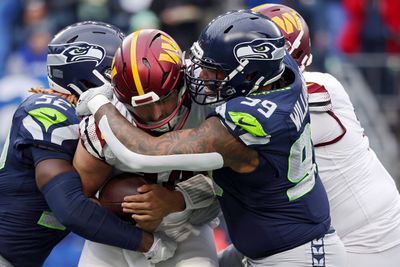
Photo by Tom Hauck/Getty Images
How Bad Was the QB at Avoiding Pressure?
The last factor contributing to Sam Howell’s high sack totals in 2023 was his own deficiency in avoiding pressure. One of the weaknesses listed in Howell’s draft profile coming into the league was: “Takes too many unnecessary sacks.” In his final year at UNC his Pressure to Sack Rate of 31.8% was the second highest among QBs in the Power Five (min 148 dropbacks).
In his first season starting in the NFL, Howell’s Pressure to Sack Rate of 23.5% was the fourth-highest among NFL starters, only trailing Ryan Tannehill (30.2%), Bryce Young (24.5%) and Zach Wilson (24.3%).
Will Jayden Daniels fare better? He should benefit from a more balanced offensive scheme and improved interior pass blocking than his predecessor experienced. But the concern for Commanders fans is that avoidance of pressure was one of the weaker elements of his game in college. His Pressure-to-Sack Ratio of 20.2% in his final season at LSU was significantly lower than Howell’s figure in college, but it was the second-highest among the top six QB prospects in the 2024 draft, after Caleb Williams (23.2%).
Hopefully the Commanders’ coaching staff will focus on developing Daniels’ pocket awareness with virtual reality and traditional training methods, and will scheme to avoid exposing any weakness in this area as he comes up to speed with the NFL game. He is starting from a better baseline than Howell did. With better support from the coaching staff and improved pass protection up front, he has a better chance to avoid the trial by fire than his predecessor faced.
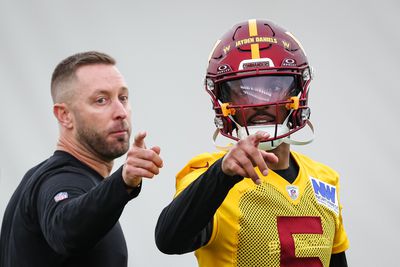
Photo by Scott Taetsch/Getty Images
Conclusion
While the offseason discussion on Hogs Haven has focused on the OT position, the biggest issue with the Commanders’ pass protection in 2023 was actually the interior offensive line. Specifically, the left guards and centers played below NFL standards for starters at their positions.
The left guard position allowed more total pressures than either OT position and the same number of sacks. That should be of particular concern to Commanders’ fans heading into the summer, since guards are expected to have lower Pressure Rates in pass protection than offensive tackles, and because the veteran free agents brought in to shore up the position are not substantially better than last year’s starters. There are several young players on the roster to compete for the starting job in camp, possibly including third-round draft pick Brandon Coleman. But at this point in time, there is no clear starter.
While the Commanders’ presumptive starters at offensive tackle heading into camp are not world-beaters, they were far from being the worst players at their positions last season. A more fitting description of the Commanders’ OT position heading into camp would be mediocre. The position will need to be upgraded in time to transform the roster to a championship contender. But the urgency of the need to get better at OT, relative to other positions on the offensive line, would appear to have been overstated.
The most underperforming position group on the offensive line, relative to expectations was center. The position was upgraded during the offseason by signing Tyler Biadasz, who was far better in pass protection than the previous season’s starter.
The choices made by the Commanders’ new front office in their first offseason were likely constrained by player availability and draft resources. The biggest free agent acquisition was directed to the interior offensive line. As it turns out, the interior offensive line was the biggest area of need in pass protection last season. Upgrading the interior OL in free agency is also much easier than upgrading edge protection, because teams seldom let quality starting tackles go.
This offseason, a small handful of offensive tackles hit free agency who would have been clear upgrades over players on the Commanders’ roster. They were all quickly snapped up by other teams or re-signed by their existing teams. Commanders’ fans should be reassured that the front office directed offseason resources to where they could have the most immediate and biggest impact with respect to improving pass protection for rookie QB Jayden Daniels.
